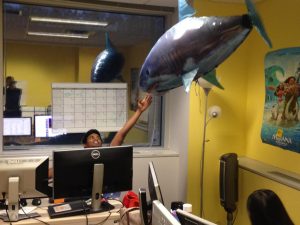So, everything we said last week about how hockey was the ideal sport for this project?
Out the window!
On Monday, our team sat down and discussed the ramifications of what we had learned from the PPG Paints arena. We decided that the limited flying range of the blimp in a hockey arena, while disappointing, wasn’t a deal-breaker: we could always come up with another way to engage guests. On the other hand, the fact that most guests left their seats in between periods was a major problem. Briefly, we considered developing an inter-period experience that could take place in the concourse surrounding the seating area, where fans flock to buy food or visit restrooms. However, a hockey-loving classmate of ours pointed out that the reason fans leave their seats in between periods is because the game is so engaging that while it is in play, they don’t want to get up, lest they miss part of the action. The breaks between periods, then, are welcome pauses that fans use to tend to their bodily needs – not unpleasant stretches of boredom that we can make better through in-stadium entertainment. Further, our classmate explained, the problem that we were trying to solve – making the stadium experience more engaging, so that more fans would come to live games – wasn’t really a problem that existed for major-league hockey. Dedicated hockey fans already enjoy the stadium experience, and only watch from home if they can’t afford tickets or live too far from the stadium. Casual sports fans don’t often attend hockey games, but not because the stadium experience is lacking; rather, they avoid hockey (both on TV and in person) because an in-depth knowledge of the game is required to be able to follow the puck.
After considering this new information, the team decided to switch our focus to baseball – specifically, minor-league baseball games. Unlike hockey fans, baseball fans are willing to leave their seats while the game is in play, which means that there is no mass exodus to the food stands and restrooms during breaks. Speaking of breaks, there are a lot of them – one at the beginning and middle of each of a baseball game’s nine innings – where the crowd relies on the stadium to provide adequate entertainment. Additionally, because the game is slower-paced than hockey, guests are more likely to engage with an activity that happens during play time than they would be in a sport such as hockey. And minor-league games are especially well-suited to our purposes because many fans come to the game just as much for the stadium entertainment as they do for the baseball game itself.
Once this decision was made, our artist spent most of the week revising our branding materials to use baseball imagery, rather than hockey imagery. Our UI Designer took a first pass at creating the fan-facing UI for the play collection game, as well as the operator-facing UI for controlling the technology on the blimp. Programmers used these UI drafts to prototype both the fan-facing and operator-facing software. Our Experience Designer designed a paper prototype for Crowd Simon, and the whole team worked together to run a playtest of the prototype.
Also, we got our toy blimp working, and confirmed that people really love interacting with blimps.

